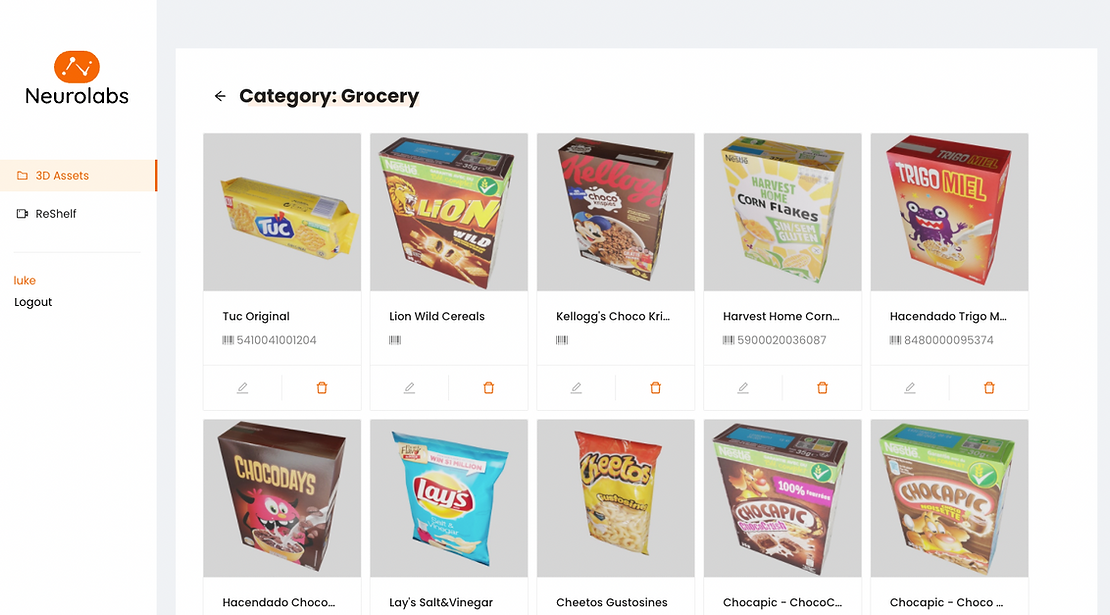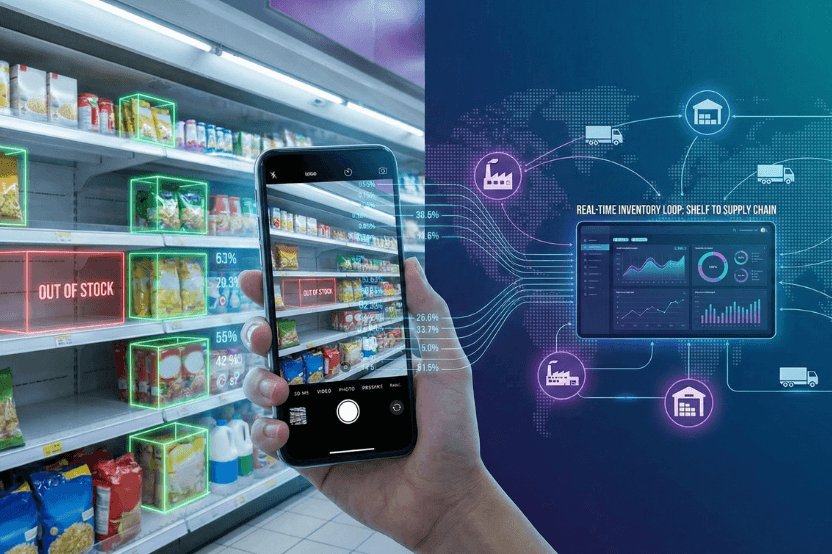Using Synthetic Computer Vision to Optimise Mobile Shelf Auditing

Automation in Sight
The rapidly changing demands of the modern consumer combined with constantly increasing competition has made effective in-store execution more critical than ever for retailers and Consumer Packaged Goods (CPG)/Fast Moving Consumer Goods (FMCG) brands alike.
For supermarkets, in-store execution requires the laborious effort of manually monitoring shelves by sight, as often as possible, with the human resources that are available to them. This is overly onerous, prone to human-error, and difficult to scale.
For CPG brands, in-store execution can be carried out in collaboration with the retailer using the above approach but this is quite limiting and slows down the transfer of crucial operational information that is required to make optimum merchandising decisions at speed.
More often than not, CPG brands employ thousands of field agents to visit the stores that stock their products and conduct shelf auditing on their behalf. This approach can lead to inconsistencies in data quality and result in very large overheads.
Faced with similar challenges in both shelf monitoring and shelf auditing, retailers and CPG brands are turning to automation to streamline the process. Computer Vision (CV), in particular, is playing a crucial role in the successful deployment of these automated in-store solutions.

Teaching a Computer to See
Computer Vision is a speciality of Artificial Intelligence that trains a computer to interpret and understand visual data from the real world. It is the field of computer science responsible for image recognition.
At its simplest, a series of algorithms break down the visual data of a product from an image and compare it against a database of confirmed images of that same product to determine how likely a match it is.
With a successful match, the software can use this product detection data, in collaboration with other automation tools, to carry out a specific process such as informing in-store staff when a product’s on-shelf inventory is running low.
As supermarkets and CPG brands turn to the lucrative automation promises of Computer Vision, the technology has had to undergo an evolution of sorts as the traditional approach struggles to meet the demands of modern retail.

Limited Vision
Most Computer Vision (CV) solutions on the market today rely on a process that requires massive amounts of costly real data that is unnecessarily time-consuming to collect as input to validate product detection.
Consider the thousands of product lines and hundreds of thousands of individual SKUs that an algorithm must be programmed to recognise under so many different environmental conditions.
The average modern supermarket is, of course, a dynamic, ever-changing place so any automated solution deployed in a store must be flexible enough to perform effectively. The sheer input data requirements makes traditional CV impossible to adapt and scale to the demands of even the average retailer.
Simply put, conventional CV, the most widely used form of the technology on the market today, is not a feasible or scalable approach to the demands of modern retail execution. Luckily, a new form of CV is emerging that can handle the challenge.

Unlimited Possibility
Synthetic Computer Vision (SCV) is a new approach to image recognition that utilises synthetic or computer generated datasets in the training of computer vision models. In doing so, the technology is not limited by reliance on the laborious collection and labelling of huge amounts of real data to be able to detect an object.
Neurolabs uses SCV in its technology which is purpose built to detect CPG products at the SKU-level. The synthetic data that Neurolabs uses to train its models comes in the form of 3D digital recreations of each CPG product.

By providing a synthetic copy or 3D digital twin of a product as training data to a computer vision model, the necessity for collecting hundreds or thousands of real images of that individual product is removed, drastically reducing the time and cost involved in deploying the product detection technology in a real-world retail environment.
ReShelf uses Artificial Intelligence to automatically create variations of a product’s synthetic copy as well as its environment to train itself to detect the product under variable conditions.
Consider the many different ways that a single product could be displayed on a shelf, the condition of the packaging, and the specific retail environment as just some of the many variables that the SCV approach accounts for that makes the traditional approach to computer vision so infeasible.
Using synthetic data as the training material for a computer vision model in this way means you have access to limitless image recognition applications. Endless CPG use cases are possible using the same 3D digital copy of a product from automation in manufacturing and distribution, to in-store inventory and checkout.

A Fixed Position
ReShelf is Neurolabs’ answer to the automation challenges retailers face with in-store shelf monitoring. By using Synthetic Computer Vision via fixed, in-store cameras, ReShelf excels where conventional solutions have been limited in many ways:
- Speed: A real-world deployment can be implemented in less than one week.
- Scale: Access to image recognition datasets for over 100,000 SKUs through the ReShelf platform.
- Quality: Achieve 96% accuracy for SKU-level product recognition from day 1.

Retail innovators such as Auchan have already seen the impact of using SCV with a fixed-camera deployment for in-store shelf monitoring.
For retailers, automated shelf monitoring solutions using Synthetic Computer Vision are proving to be the most scalable and impactful approach.
Using a powerful combination of fixed, in-store cameras with the latest advancement in image recognition, supermarket chains such as Auchan and UVESCO have achieved complete visibility of their store shelves in real time.
These benefits are not limited to fixed-camera setups. Neurolabs has taken the power of Synthetic Computer Vision and proven that it is transferable to a mobile use case. Using synthetic data, Neurolabs has made it possible for CPG brands to achieve similar success with shelf auditing on the go.

Going Mobile
Neurolabs is now providing the automation potential of Synthetic Computer Vision from a mobile device by transferring the lessons learned from fixed-camera shelf monitoring to the mobile shelf auditing use case.
CPG brands can now streamline retail execution with access to SKU-level image recognition technology without the need for in-store fixed cameras.
With real-time product detection available on the go, your field force are empowered with the right information at the right time to execute in-store brand strategy most effectively.
Field agents simply upload shelf images from their mobiles devices to the Neurolabs API which will automatically stitch the images together to generate a complete scene for SKU-level detection.
SKU-level analysis provides you with detailed information to compute your most important retail execution KPIs such as Out-Of-Shelf rate, shelf share percentage, competitor price comparison, and so much more. With complete visibility of your product in real time, you can quickly and easily tailor your merchandising strategy at the store level.

Insights in Hand
As the demands of a growing consumer base combined with ever-increasing competition continue to grow, CPG brands are faced with the daunting task of maintaining the best possible merchandising experience across many different markets and locations.
Automation is critical to a successful and cost-effective in-store brand strategy and yet many CPG brands continue to rely on the manual intervention of their field agents to give them a complete picture of product performance from the shop floor.
Using synthetic data with Computer Vision enables the speed, flexibility, and scalability needed to deploy an effective automated solution to retail execution.
Achieving next-level retail activity optimisation and optimising your in-store retail execution strategy is now so much simpler with Neurolabs.

Retailers worldwide lose a mind-blowing $634 Billion annually due to the cost of poor inventory management with 5% of all sales lost due to Out-Of-Stocks alone.
Neurolabs helps optimise in-store retail execution for supermarkets and CPG brands using a powerful combination of computer vision and synthetic data, improving customer experience and increasing revenue.




